Coverage Path Planning and Point-of-Interest Detection Using Autonomous Drone Swarms
Abstract
1. Introduction
2. Past Related Work
3. Autonomous Area Coverage Algorithm
3.1. Swarm Formation
| Algorithm 1: Drone Swarm Border Align for Scanning. |
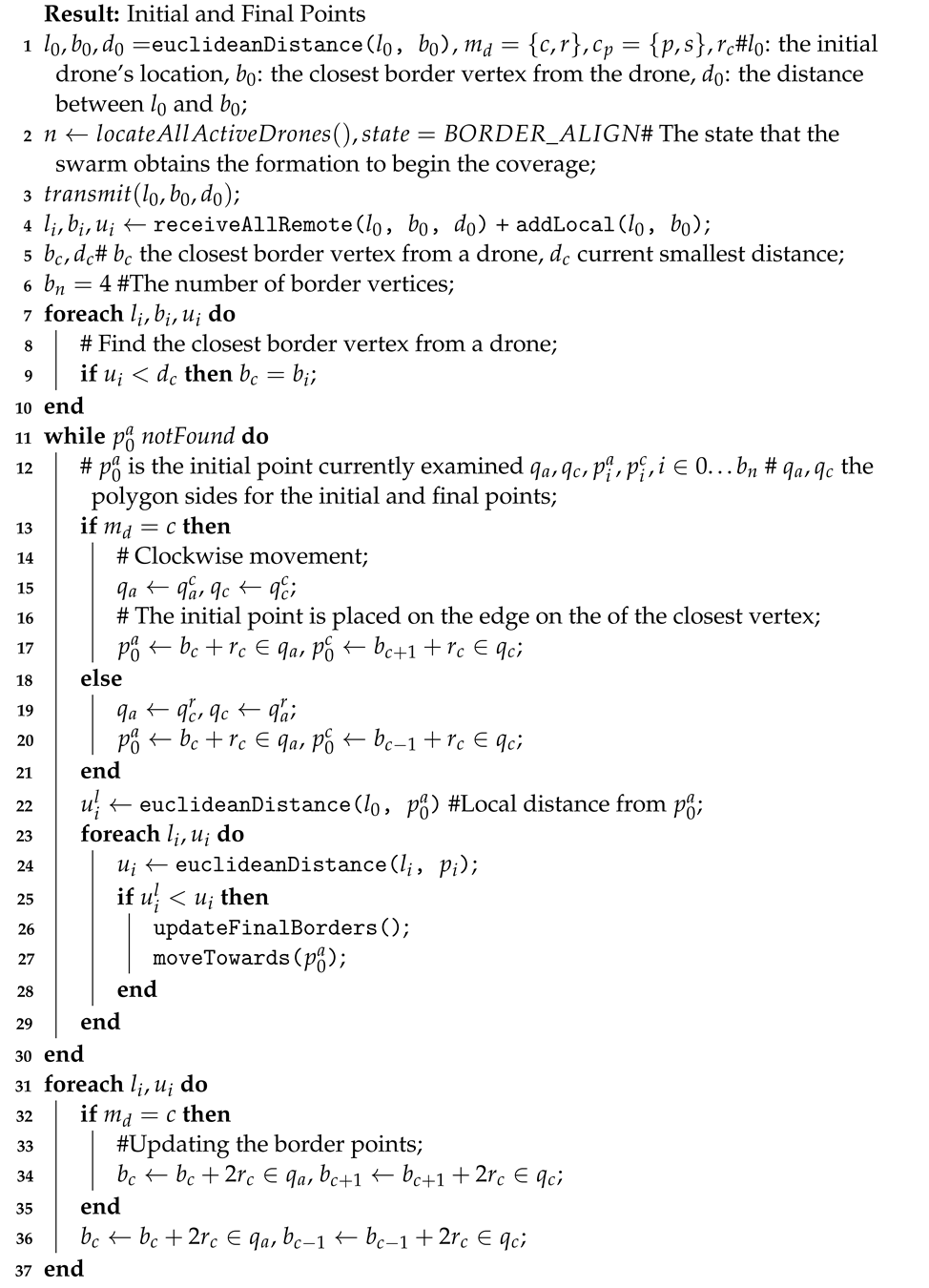 |
3.2. Partial Linear Area Coverage
| Algorithm 2: Partial Area Coverage in Straight-Line Movement. |
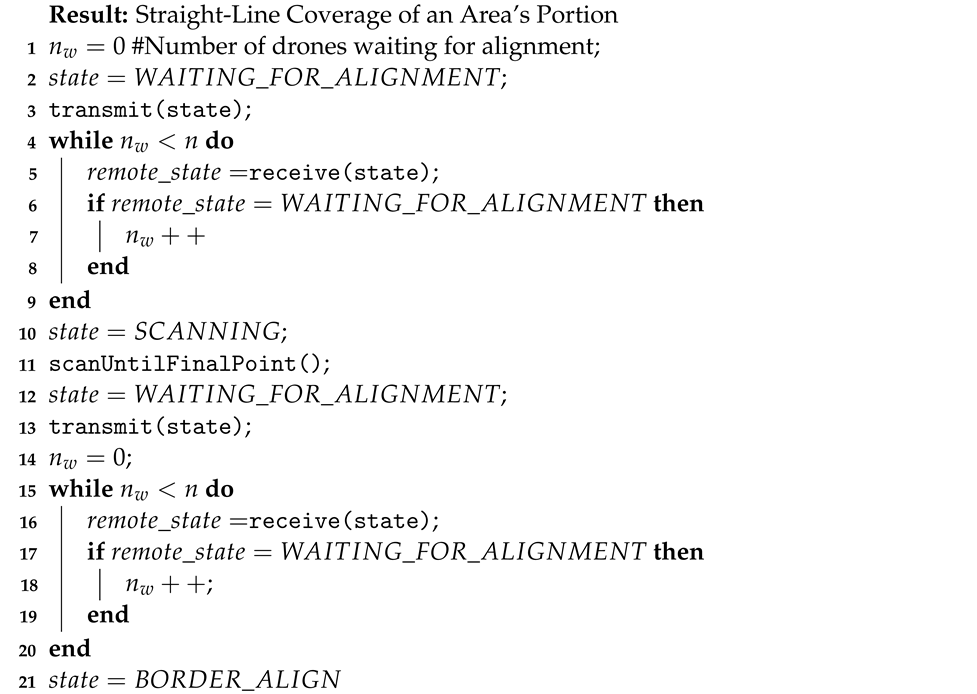 |
3.3. Point-of-Interest Detection Models
3.4. Coverage Paths
4. Simulation Results
4.1. Simulated Environment and Parameter Setup
4.2. Results
4.2.1. Full Coverage Distance Analysis
4.2.2. General Performance Analysis
5. Conclusions and Future Work
Author Contributions
Funding
Institutional Review Board Statement
Informed Consent Statement
Data Availability Statement
Conflicts of Interest
References
- Hambling, D. Swarm Troopers: How Small Drones Will Conquer the World; Publishing Services Provided by Archangel Ink: Venice, FL, USA, 2015. [Google Scholar]
- Yamazaki, F.; Liu, W. Remote sensing technologies for post-earthquake damage assessment: A case study on the 2016 Kumamoto earthquake. In Proceedings of the 6th Asia Conference on Earthquake Engineering, Cebu City, Philippines, 22–24 September 2016; p. 8. [Google Scholar]
- Kinaneva, D.; Hristov, G.; Raychev, J.; Zahariev, P. Early forest fire detection using drones and artificial intelligence. In Proceedings of the 2019 42nd International Convention on Information and Communication Technology, Electronics and Microelectronics (MIPRO), Opatija, Croatia, 20–24 May 2019; pp. 1060–1065. [Google Scholar]
- Pham, H.X.; La, H.M.; Feil-Seifer, D.; Deans, M. A distributed control framework for a team of unmanned aerial vehicles for dynamic wildfire tracking. In Proceedings of the 2017 IEEE/RSJ International Conference on Intelligent Robots and Systems (IROS), Vancouver, BC, Canada, 24–28 September 2017; pp. 6648–6653. [Google Scholar]
- Hong, I.; Kuby, M.; Murray, A. A deviation flow refueling location model for continuous space: A commercial drone delivery system for urban areas. In Advances in Geocomputation; Springer: Berlin/Heidelberg, Germany, 2017; pp. 125–132. [Google Scholar]
- Bamburry, D. Drones: Designed for product delivery. Des. Manag. Rev. 2015, 26, 40–48. [Google Scholar]
- Guerrero, J.A.; Bestaoui, Y. UAV path planning for structure inspection in windy environments. J. Intell. Robot. Syst. 2013, 69, 297–311. [Google Scholar] [CrossRef]
- Chang, W.; Yang, G.; Yu, J.; Liang, Z.; Cheng, L.; Zhou, C. Development of a power line inspection robot with hybrid operation modes. In Proceedings of the 2017 IEEE/RSJ International Conference on Intelligent Robots and Systems (IROS), Vancouver, BC, Canada, 24–28 September 2017; pp. 973–978. [Google Scholar]
- Campion, M.; Ranganathan, P.; Faruque, S. UAV swarm communication and control architectures: A review. J. Unmanned Veh. Syst. 2018, 7, 93–106. [Google Scholar] [CrossRef]
- Lomonaco, V.; Trotta, A.; Ziosi, M.; Avila, J.D.D.Y.; Díaz-Rodríguez, N. Intelligent drone swarm for search and rescue operations at sea. arXiv 2018, arXiv:1811.05291. [Google Scholar]
- Kumar, S.V.; Jayaparvathy, R.; Priyanka, B. Efficient path planning of AUVs for container ship oil spill detection in coastal areas. Ocean. Eng. 2020, 217, 107932. [Google Scholar] [CrossRef]
- Odonkor, P.; Ball, Z.; Chowdhury, S. Distributed operation of collaborating unmanned aerial vehicles for time-sensitive oil spill mapping. Swarm Evol. Comput. 2019, 46, 52–68. [Google Scholar] [CrossRef]
- Luo, S.; Singh, Y.; Yang, H.; Bae, J.H.; Dietz, J.E.; Diao, X.; Min, B.C. Image processing and model-based spill coverage path planning for unmanned surface vehicles. In Proceedings of the OCEANS 2019 MTS/IEEE SEATTLE, Vancouver, BC, Canada, 24–28 September 2019; pp. 1–9. [Google Scholar]
- Innocente, M.S.; Grasso, P. Self-organising swarms of firefighting drones: Harnessing the power of collective intelligence in decentralised multi-robot systems. J. Comput. Sci. 2019, 34, 80–101. [Google Scholar] [CrossRef]
- Ausonio, E.; Bagnerini, P.; Ghio, M. Drone Swarms in Fire Suppression Activities: A Conceptual Framework. Drones 2021, 5, 17. [Google Scholar] [CrossRef]
- Yuan, C.; Zhang, Y.; Liu, Z. A survey on technologies for automatic forest fire monitoring, detection, and fighting using unmanned aerial vehicles and remote sensing techniques. Can. J. For. Res. 2015, 45, 783–792. [Google Scholar] [CrossRef]
- Chen, H.; Wang, X.m.; Li, Y. A survey of autonomous control for UAV. In Proceedings of the 2009 International Conference on Artificial Intelligence and Computational Intelligence, Shanghai, China, 7–8 November 2009; Volume 2, pp. 267–271. [Google Scholar]
- Cicek, C.T.; Gultekin, H.; Tavli, B.; Yanikomeroglu, H. UAV base station location optimization for next generation wireless networks: Overview and future research directions. In Proceedings of the 2019 1st International Conference on Unmanned Vehicle Systems-Oman (UVS), Muscat, Oman, 5–7 February 2019; pp. 1–6. [Google Scholar]
- Katsigiannis, P.; Misopolinos, L.; Liakopoulos, V.; Alexandridis, T.K.; Zalidis, G. An autonomous multi-sensor UAV system for reduced-input precision agriculture applications. In Proceedings of the 2016 24th Mediterranean Conference on Control and Automation (MED), Athens, Greece, 21–24 June 2016; pp. 60–64. [Google Scholar]
- Zhao, B.; Chen, X.; Zhao, X.; Jiang, J.; Wei, J. Real-time UAV autonomous localization based on smartphone sensors. Sensors 2018, 18, 4161. [Google Scholar] [CrossRef]
- Doherty, P.; Rudol, P. A UAV search and rescue scenario with human body detection and geolocalization. In Proceedings of the Australasian Joint Conference on Artificial Intelligence, Sydney, Australia, 2–6 December 2007; Springer: Berlin, Germany, 2007; pp. 1–13. [Google Scholar]
- Gaszczak, A.; Breckon, T.P.; Han, J. Real-time people and vehicle detection from UAV imagery. In Proceedings of the Intelligent Robots and Computer Vision XXVIII: Algorithms and Techniques, San Francisco, CA, USA, 23–27 December 2011; Volume 7878, p. 78780B. [Google Scholar]
- Alfeo, A.L.; Cimino, M.G.; De Francesco, N.; Lega, M.; Vaglini, G. Design and simulation of the emergent behavior of small drones swarming for distributed target localization. J. Comput. Sci. 2018, 29, 19–33. [Google Scholar] [CrossRef]
- Jin, N.; Ma, R.; Lv, Y.; Lou, X.; Wei, Q. A novel design of water environment monitoring system based on wsn. In Proceedings of the 2010 International Conference on Computer Design and Applications, Qinhuangdao, China, 25–27 June 2010; Volume 2, p. V2-593. [Google Scholar]
- Carle, J.; Simplot-Ryl, D. Energy-efficient area monitoring for sensor networks. Computer 2004, 37, 40–46. [Google Scholar] [CrossRef]
- Ahmed, A.; Ali, J.; Raza, A.; Abbas, G. Wired vs wireless deployment support for wireless sensor networks. In Proceedings of the TENCON 2006–2006 IEEE Region 10 Conference, Hong Kong, China, 14–17 November 2006; pp. 1–3. [Google Scholar]
- Ab Aziz, N.A.B.; Mohemmed, A.W.; Alias, M.Y. A wireless sensor network coverage optimization algorithm based on particle swarm optimization and Voronoi diagram. In Proceedings of the 2009 International Conference on Networking, Sensing and Control, Okayama, Japan, 26–29 March 2009; pp. 602–607. [Google Scholar]
- Ren, J.; Zhang, Y.; Zhang, K.; Liu, A.; Chen, J.; Shen, X.S. Lifetime and energy hole evolution analysis in data-gathering wireless sensor networks. IEEE Trans. Ind. Inform. 2015, 12, 788–800. [Google Scholar] [CrossRef]
- Yuan, C.; Liu, Z.; Zhang, Y. Fire detection using infrared images for UAV-based forest fire surveillance. In Proceedings of the 2017 International Conference on Unmanned Aircraft Systems (ICUAS), Miami, FL, USA, 13–16 June 2017; pp. 567–572. [Google Scholar]
- Popescu, D.; Dragana, C.; Stoican, F.; Ichim, L.; Stamatescu, G. A collaborative UAV-WSN network for monitoring large areas. Sensors 2018, 18, 4202. [Google Scholar] [CrossRef] [PubMed]
- Câmara, D. Cavalry to the rescue: Drones fleet to help rescuers operations over disasters scenarios. In Proceedings of the 2014 IEEE Conference on Antenna Measurements &Applications (CAMA), Antibes Juan-les-Pins, France, 16–19 November 2014; pp. 1–4. [Google Scholar]
- Kingston, D.; Beard, R.W.; Holt, R.S. Decentralized perimeter surveillance using a team of UAVs. IEEE Trans. Robot. 2008, 24, 1394–1404. [Google Scholar] [CrossRef]
- Yang, F.; Wang, P.; Zhang, Y.; Zheng, L.; Lu, J. Survey of swarm intelligence optimization algorithms. In Proceedings of the 2017 IEEE International Conference on Unmanned Systems (ICUS), Beijing, China, 27–29 October 2017; pp. 544–549. [Google Scholar]
- Cheikhrouhou, O.; Khoufi, I. A comprehensive survey on the Multiple Traveling Salesman Problem: Applications, approaches and taxonomy. Comput. Sci. Rev. 2021, 40, 100369. [Google Scholar] [CrossRef]
- Khader, A.T.; Al-betar, M.A.; Mohammed, A.A. Artificial Bee Colony Algorithm, Its Variants and Applications: A Survey; Citeseer: Princeton, NJ, USA, 2013. [Google Scholar]
- Teodorović, D. Bee colony optimization (BCO). In Innovations in Swarm Intelligence; Springer: Berlin/Heidelberg, Germany, 2009; pp. 39–60. [Google Scholar]
- Karaboga, D.; Akay, B. A survey: Algorithms simulating bee swarm intelligence. Artif. Intell. Rev. 2009, 31, 61. [Google Scholar] [CrossRef]
- Gambardella, M.; Martinoli, M.B.A.; Stützle, R.P.T. Ant colony optimization and swarm intelligence. In Proceedings of the 5th International Workshop, Sydney, Australia, 20–21 September 2006. [Google Scholar]
- Selvi, V.; Umarani, R. Comparative analysis of ant colony and particle swarm optimization techniques. Int. J. Comput. Appl. 2010, 5, 975–8887. [Google Scholar] [CrossRef]
- Yang, Q.W.; Ruan, S.N.; Chen, J.F.; Li, B. Application Survey on Swarm Intelligence in the Traveling Salesman Problem. Tech. Autom. Appl. 2016, 8, 1–6. [Google Scholar]
- Reed, M.; Yiannakou, A.; Evering, R. An ant colony algorithm for the multi-compartment vehicle routing problem. Appl. Soft Comput. 2014, 15, 169–176. [Google Scholar] [CrossRef]
- Otto, A.; Agatz, N.; Campbell, J.; Golden, B.; Pesch, E. Optimization approaches for civil applications of unmanned aerial vehicles (UAVs) or aerial drones: A survey. Networks 2018, 72, 411–458. [Google Scholar] [CrossRef]
- Cabreira, T.M.; Brisolara, L.B.; Ferreira, P.R., Jr. Survey on coverage path planning with unmanned aerial vehicles. Drones 2019, 3, 4. [Google Scholar] [CrossRef]
- Nam, L.; Huang, L.; Li, X.J.; Xu, J. An approach for coverage path planning for UAVs. In Proceedings of the 2016 IEEE 14th international workshop on advanced motion control (AMC), Auckland, New Zealand, 22–24 April 2016; pp. 411–416. [Google Scholar]
- Li, Y.; Chen, H.; Er, M.J.; Wang, X. Coverage path planning for UAVs based on enhanced exact cellular decomposition method. Mechatronics 2011, 21, 876–885. [Google Scholar] [CrossRef]
- McGuire, K.; De Wagter, C.; Tuyls, K.; Kappen, H.; de Croon, G.C. Minimal navigation solution for a swarm of tiny flying robots to explore an unknown environment. Sci. Robot. 2019, 4. [Google Scholar] [CrossRef] [PubMed]
- Xia, Y.; Chen, C.; Shi, J.; Liu, Y.; Li, G. Two-Layer Path Planning for Multi-Area Coverage by a Cooperated Ground Vehicle and Drone System. 2020. Available online: https://www.researchgate.net/publication/346526962_Two-Layer_Path_Planning_for_Multi-Area_Coverage_by_a_Cooperated_Ground_Vehicle_and_Drone_System (accessed on 5 September 2022).
- Skiadopoulos, K.; Giannakis, K.; Tsipis, A.; Oikonomou, K.; Stavrakakis, I. Impact of drone route geometry on information collection in wireless sensor networks. Ad Hoc Netw. 2020, 106, 102220. [Google Scholar] [CrossRef]
- Vazquez-Carmona, E.V.; Vasquez-Gomez, J.I.; Herrera-Lozada, J.C.; Antonio-Cruz, M. Coverage path planning for spraying drones. Comput. Ind. Eng. 2022, 168, 108125. [Google Scholar] [CrossRef] [PubMed]
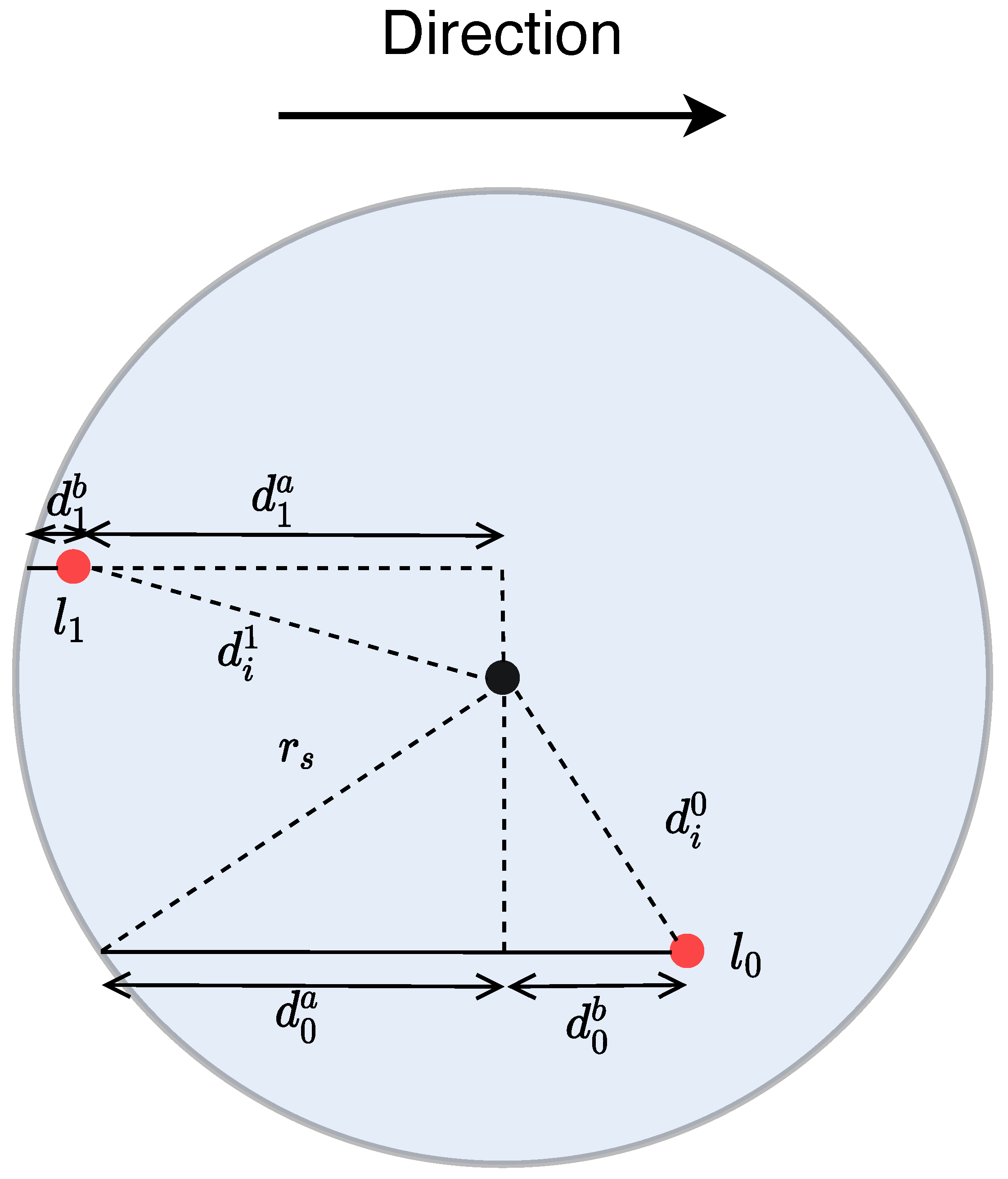


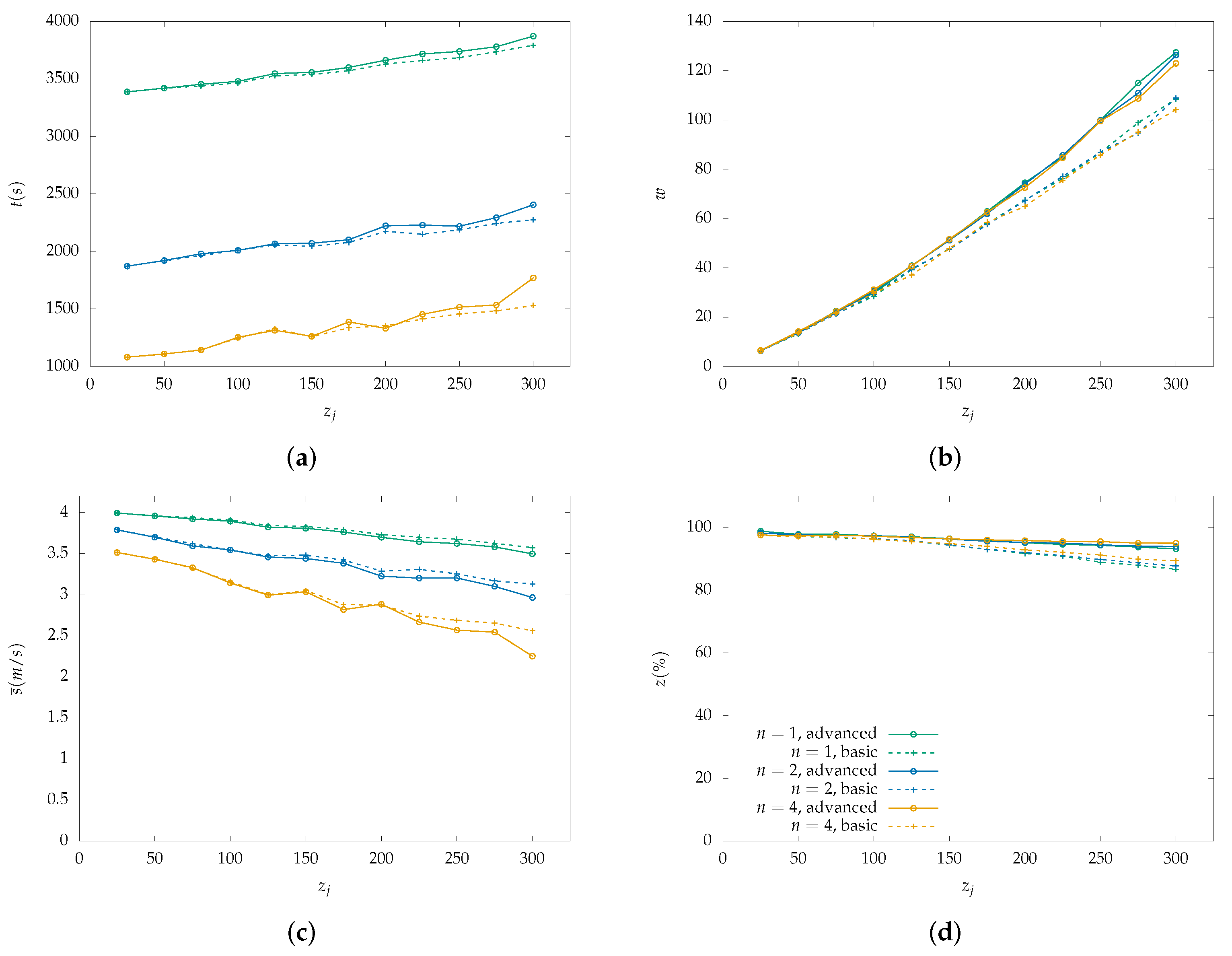
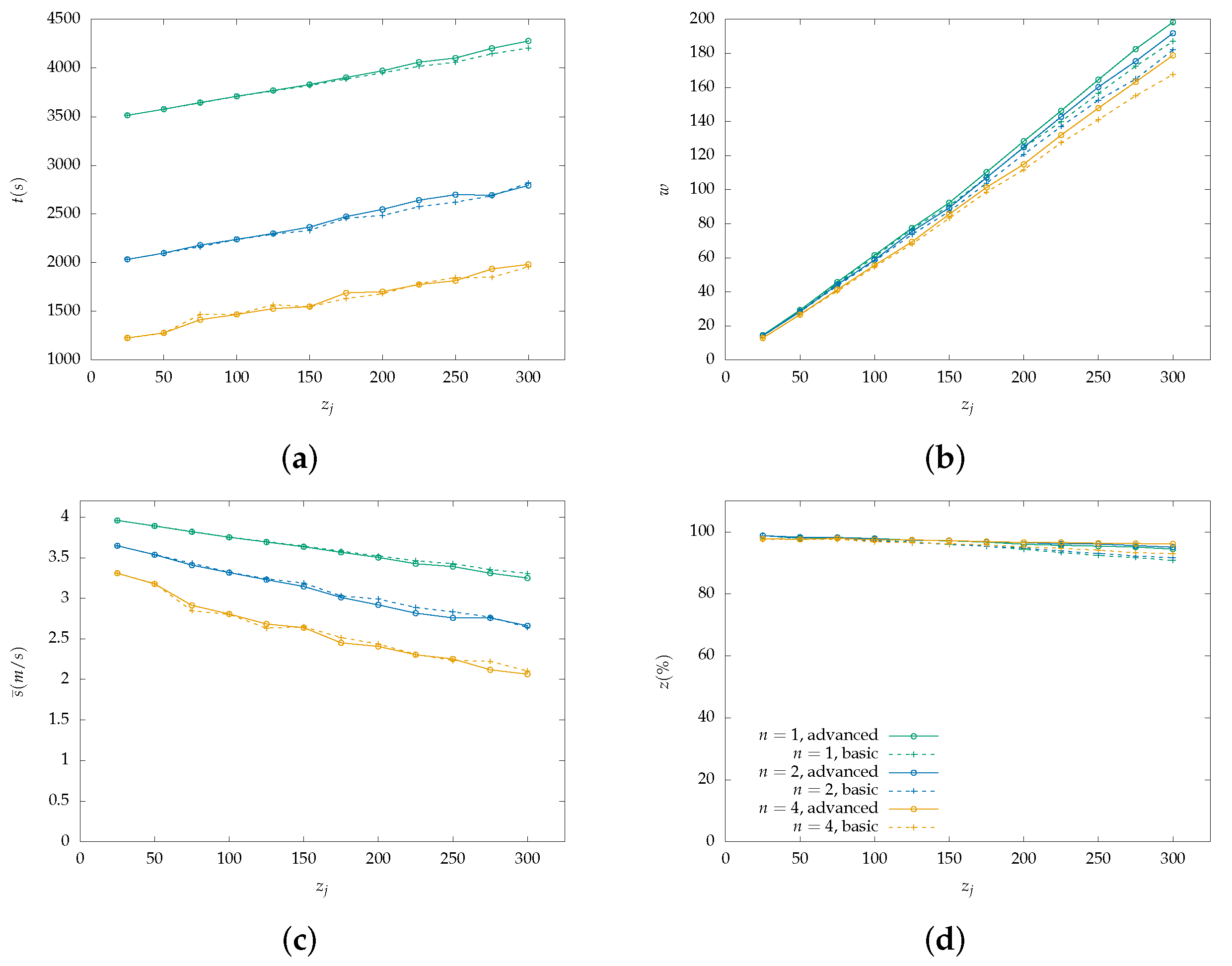

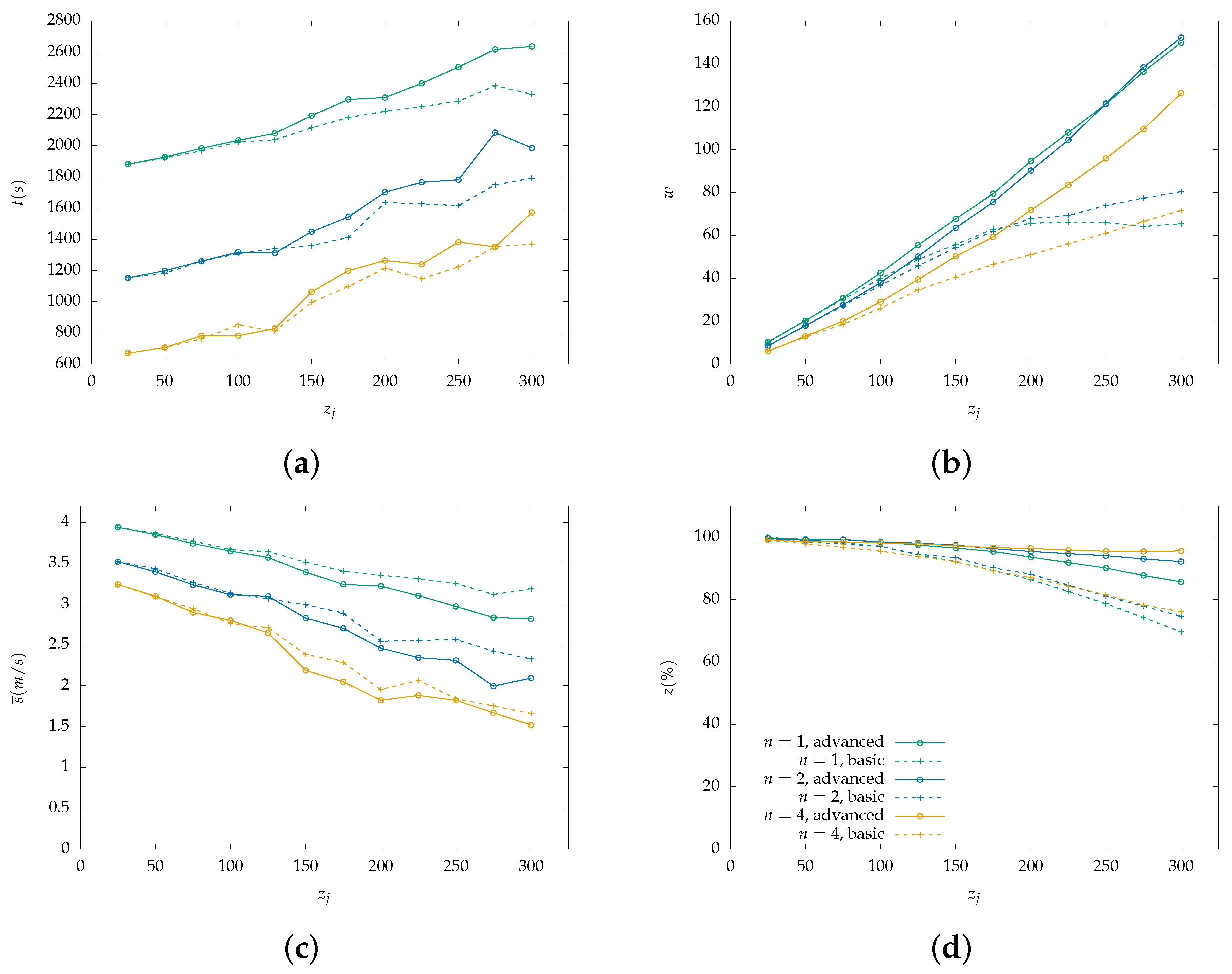
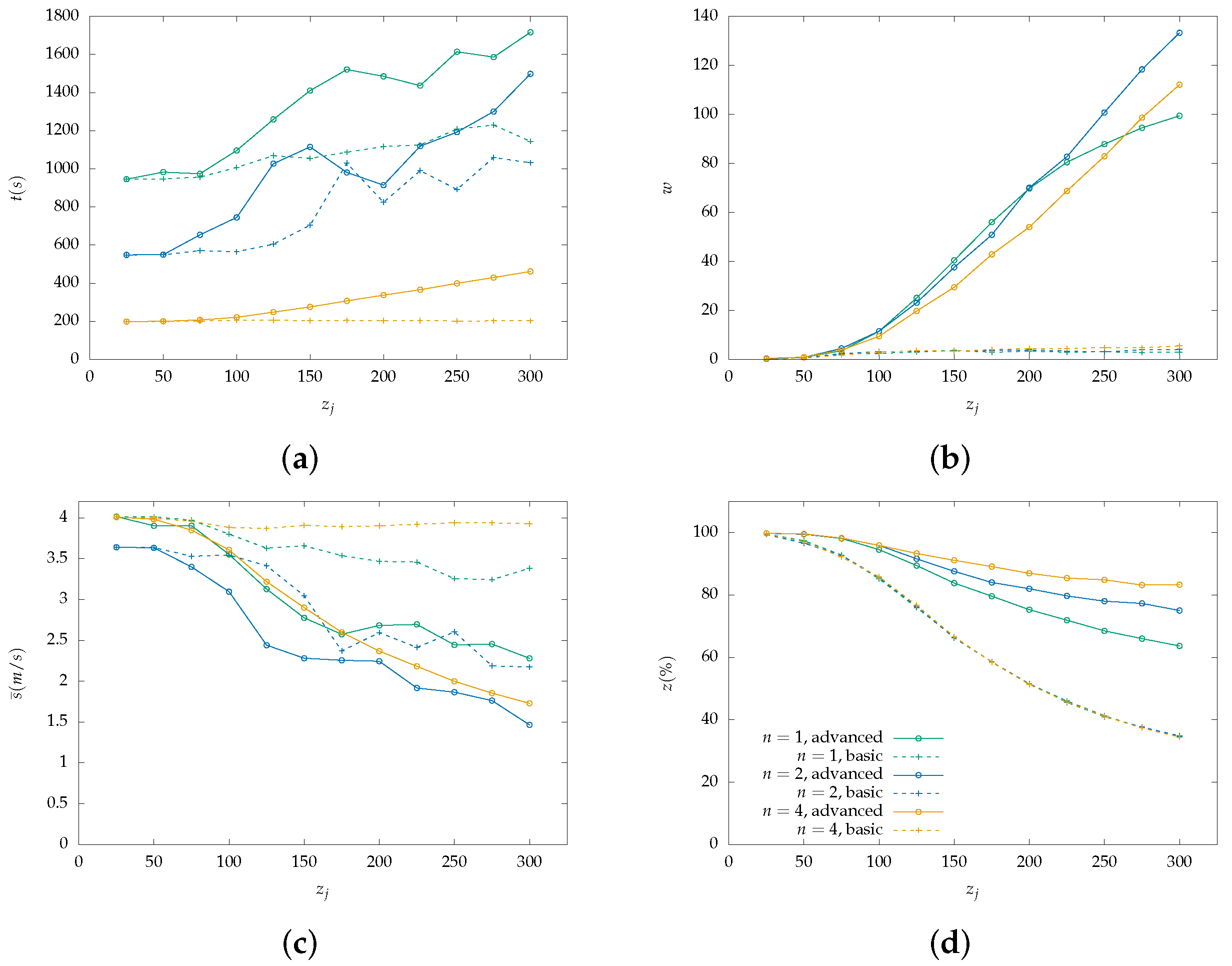
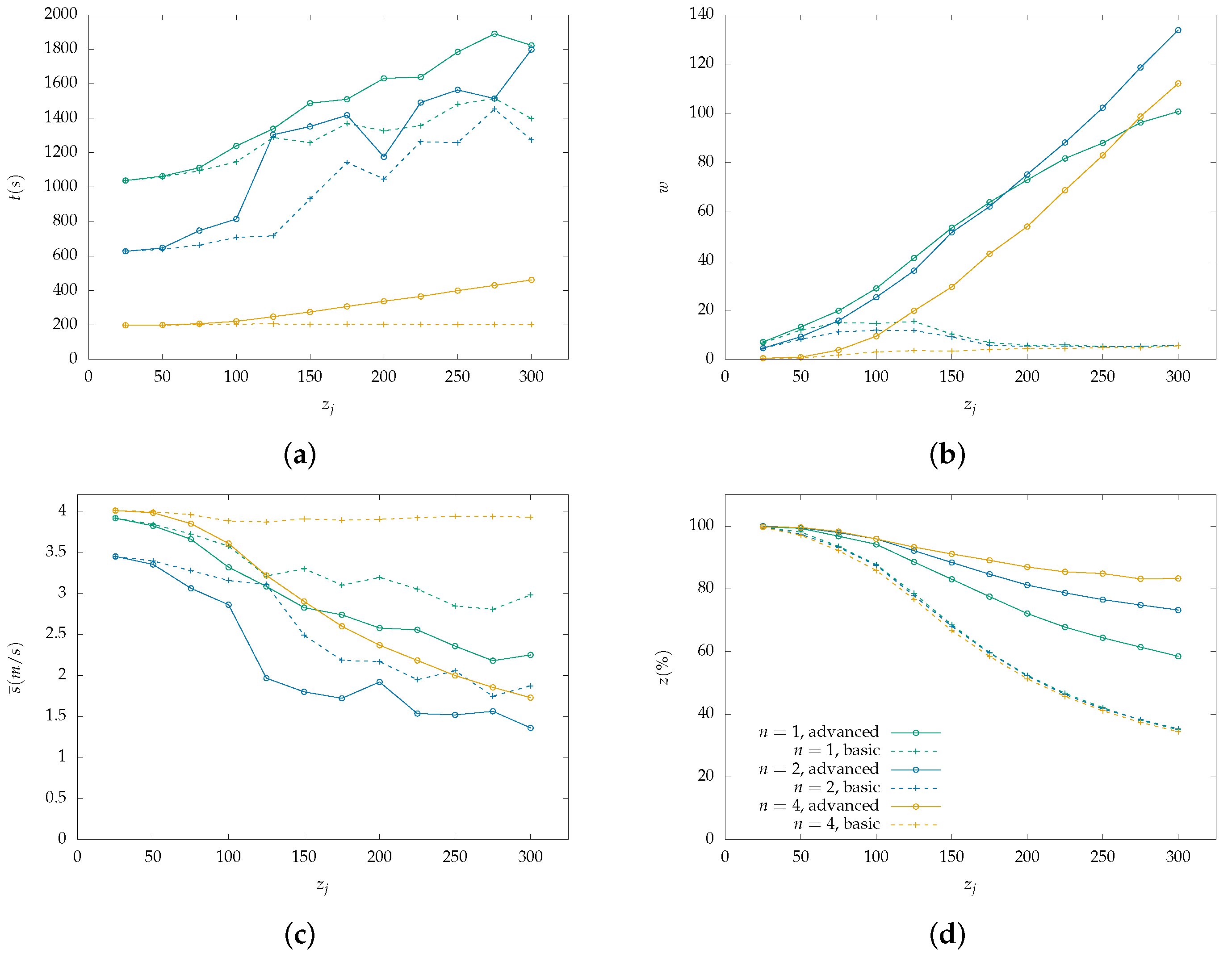
| Name | Symbol | Potential Values |
|---|---|---|
| Swarm size | n | 1, 2, 4 |
| Coverage radius | 25, 50, 100 | |
| # of PoIs | 25, 50, 75, …, 300 | |
| Movement direction | c, r | |
| Swarm maximum speed | s | 4 m/s or 14.2 km/h |
| Swarm mean speed | - | |
| Mean travel distance per drone | - | |
| Distance outside borders | - | |
| # of formation switches | f | - |
| Time for coverage | t | - |
| # of slowdowns | w | - |
| Mean # of formation switches | - |
Publisher’s Note: MDPI stays neutral with regard to jurisdictional claims in published maps and institutional affiliations. |
© 2022 by the authors. Licensee MDPI, Basel, Switzerland. This article is an open access article distributed under the terms and conditions of the Creative Commons Attribution (CC BY) license (https://creativecommons.org/licenses/by/4.0/).
Share and Cite
Bezas, K.; Tsoumanis, G.; Angelis, C.T.; Oikonomou, K. Coverage Path Planning and Point-of-Interest Detection Using Autonomous Drone Swarms. Sensors 2022, 22, 7551. https://doi.org/10.3390/s22197551
Bezas K, Tsoumanis G, Angelis CT, Oikonomou K. Coverage Path Planning and Point-of-Interest Detection Using Autonomous Drone Swarms. Sensors. 2022; 22(19):7551. https://doi.org/10.3390/s22197551
Chicago/Turabian StyleBezas, Konstantinos, Georgios Tsoumanis, Constantinos T. Angelis, and Konstantinos Oikonomou. 2022. "Coverage Path Planning and Point-of-Interest Detection Using Autonomous Drone Swarms" Sensors 22, no. 19: 7551. https://doi.org/10.3390/s22197551
APA StyleBezas, K., Tsoumanis, G., Angelis, C. T., & Oikonomou, K. (2022). Coverage Path Planning and Point-of-Interest Detection Using Autonomous Drone Swarms. Sensors, 22(19), 7551. https://doi.org/10.3390/s22197551









